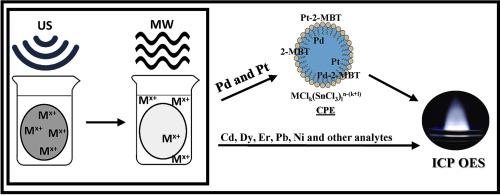Talanta ( IF 6.1 ) Pub Date : 2020-07-31 , DOI: 10.1016/j.talanta.2020.121457 Eduardo José dos Santos Souza , Camilo Zapata Mora , Beatriz Helena Aristizábal Zuluaga , Clarice Dias Britto do Amaral , Marco Tadeu Grassi

|
The complexity of aerodynamic particulate matter's (PM) matrices poses a challenge for the extraction and quantification of metals, especially for analytes with low concentration. Aiming to solve this issue, a precise and accurate protocol with the ultrasound extraction combined with microwave radiation digestion (USMW), was applied to PM samples with excellent compensations in sample throughput, digestion efficiency, and energy consumption. After the digestion and extraction procedures, the inorganic analytes, including rare earth elements, were determined by ICP OES. Two types of particulate matter sampled from two stations, Gobernacion (GOB10 and GOB2.5) and Milan (MIL10), corresponding to PM2.5 and PM10, were digested with a combination between HF, HNO3, and H3BO3. The absolute limits of detection ranged from 0.42 pg m-³ for V, to 3459 pg m-³ for As. The accuracy of the experimental study was assessed using two certified reference materials (CRMs), Coal Fly Ash (NIST1633b) and Fly Ash (BCR176). The method presented good accuracy, with recoveries ranging from 90 to 115%, except for Al (120%) and Fe (123%). Considering the replicates for the determination of analyte elements, the repeatability was below 10% for the relative standard deviation (RSD). A cloud point extraction (CPE) procedure, with parameters optimized for the determination of Pd and Pt, was successfully applied in digested PM samples with detection limits of 1.43 and 2.05 pg m−³ for Pd and Pt in MIL10 sample, respectively, and 76.6 pg m−³ for Pd and 110 pg m−³ for Pt, in samples GOB10 and GOB2.5, respectively.
中文翻译:

ICP OES对PM 2.5和PM 10颗粒物进行多元素分析
空气动力学颗粒物(PM)矩阵的复杂性对金属的提取和定量提出了挑战,特别是对于低浓度的分析物。为了解决这个问题,将超声提取与微波辐射消解(USMW)相结合的精确而精确的方案应用于PM样品,并在样品通量,消解效率和能耗方面进行了出色的补偿。经过消解和提取程序后,通过ICP OES测定了包括稀土元素在内的无机分析物。用HF,HNO 3组合消解了从两个站采样的两种颗粒物,分别对应于PM 2.5和PM 10,分别是Gobernacion(GOB10和GOB2.5)和Milan(MIL10)。和H 3 BO 3。检测的绝对限制从0.42 PG M不等- ³为V,以3459 PG M - ³对As。使用两种认证的参考材料(CRM)煤粉煤灰(NIST1633b)和粉煤灰(BCR176)评估了实验研究的准确性。该方法具有良好的准确性,除Al(120%)和Fe(123%)外,回收率在90%至115%之间。考虑到用于测定分析物元素的重复,相对标准偏差(RSD)的重复性低于10%。浊点萃取(CPE)的程序,与参数Pd和Pt的测定优化,成功消化的PM样品中施加的1.43和2.05 PG M的检测限-在MIL10样品中,Pd和Pt分别为³,在样品GOB10和GOB2.5中,Pd分别为76.6 pg m - ³和Pt为110 pg m - ³。



























 京公网安备 11010802027423号
京公网安备 11010802027423号